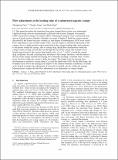| dc.contributor.author | Chen, Zhengbing | |
| dc.contributor.author | Jiang, Chunbo | |
| dc.contributor.author | Nepf, Heidi | |
| dc.date.accessioned | 2014-03-27T15:07:45Z | |
| dc.date.available | 2014-03-27T15:07:45Z | |
| dc.date.issued | 2013-09 | |
| dc.date.submitted | 2013-07 | |
| dc.identifier.issn | 00431397 | |
| dc.identifier.uri | http://hdl.handle.net/1721.1/85923 | |
| dc.description.abstract | This paper describes the transition from open channel flow to flow over submerged vegetation using velocity measurements collected with acoustic Doppler velocimetry (ADV) and particle-image velocimetry (PIV). Submerged canopies were constructed from arrays of rigid circular cylinders of height h in water of depth H. Both the canopy density, described by the frontal area per volume (a), and degree of submergence (H/h) were varied. Flow adjustment occurs in three stages. First, velocity begins to decelerate upstream of the canopy, due to a high-pressure region generated at the canopy leading edge, and continues to decelerate within the canopy, due to canopy drag. Rapid flow deceleration within the canopy creates strong vertical flux out through the top of the canopy that extends over a length proportional to the canopy drag length scale, (CDa)−1, with CD being the canopy drag coefficient. Second, a mixing layer develops at the canopy interface, with the stress at the top of the canopy initially increasing, but eventually reaching a constant value. At this point, the flow within the canopy is fully developed. The length scale for mixing-layer development is related to canopy drag (CDa) and the depth ratio (H/h). In the third stage, the boundary layer above the mixing layer adjusts to the channel boundary conditions. A model is developed to predict the adjustment of vertically averaged velocity within the canopy. Measurements confirm that the flow adjustment is not dependent on canopy length. | en_US |
| dc.description.sponsorship | National Science Foundation (U.S.) (grant AGS-1005480) | en_US |
| dc.description.sponsorship | China Scholarship Council | en_US |
| dc.description.sponsorship | Natural Sciences and Engineering Research Council of Canada (51279082) | en_US |
| dc.language.iso | en_US | |
| dc.publisher | American Geophysical Union | en_US |
| dc.relation.isversionof | http://dx.doi.org/10.1002/wrcr.20403 | en_US |
| dc.rights | Article is made available in accordance with the publisher's policy and may be subject to US copyright law. Please refer to the publisher's site for terms of use. | en_US |
| dc.source | Prof. Nepf | en_US |
| dc.title | Flow adjustment at the leading edge of a submerged aquatic canopy | en_US |
| dc.type | Article | en_US |
| dc.identifier.citation | Chen, Zhengbing, Chunbo Jiang, and Heidi Nepf. “Flow Adjustment at the Leading Edge of a Submerged Aquatic Canopy.” Water Resources Research 49, no. 9 (September 2013): 5537–5551. | en_US |
| dc.contributor.department | Massachusetts Institute of Technology. Department of Civil and Environmental Engineering | en_US |
| dc.contributor.mitauthor | Chen, Zhengbing | en_US |
| dc.contributor.mitauthor | Nepf, Heidi | en_US |
| dc.relation.journal | Water Resources Research | en_US |
| dc.eprint.version | Final published version | en_US |
| dc.type.uri | http://purl.org/eprint/type/JournalArticle | en_US |
| eprint.status | http://purl.org/eprint/status/PeerReviewed | en_US |
| dspace.orderedauthors | Chen, Zhengbing; Jiang, Chunbo; Nepf, Heidi | en_US |
| mit.license | PUBLISHER_POLICY | en_US |
| mit.metadata.status | Complete | |
